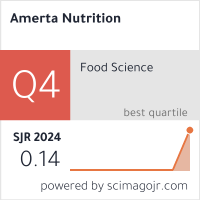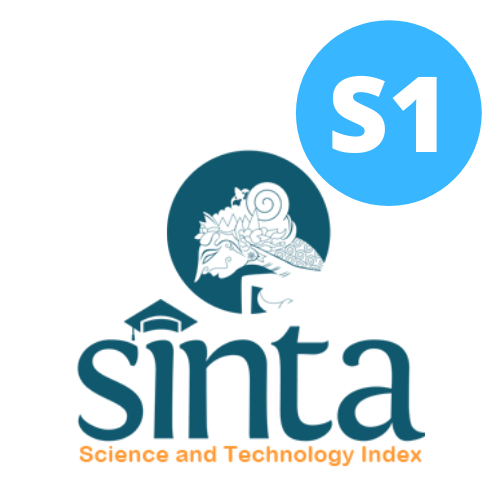Analysis of Sociodemographic Factors and Complementary Feeding Patterns on Nutritional Status of Children under Two Years in Coastal Areas of North Sumatra
Analisis Faktor Sosiodemografi dan Pola Pemberian MP ASI terhadap Status Gizi Anak di Bawah Dua Tahun di Wilayah Pesisir Sumatera Utara
Background: Nutritional status is an indicator of growth, and the first two years of a child's life should be closely observed because it is a critical period for development. Failure to grow during this period will affect nutritional status. Many factors affect a child's nutritional status, including sociodemographic factors and patterns of complementary feeding of breast milk.
Objectives: This study aimed to analyze the influence of sociodemographic factors and patterns of complementary feeding on the nutritional status of children under two years old in coastal areas of North Sumatra.
Methods: This study used a cross-sectional approach involving 212 mother-child pairs aged 6-23 months in Pantai Labu District. Data collection involved structured questionnaires and interviews covering family characteristics, initial food introduction, breastfeeding status, and child age. Nutritional status was assessed through child length and weight measurements. Multiple logistic regression tests were conducted for multivariate analysis, and bivariate tests using chi-square.
Results: The results showed that there was an influence of maternal knowledge (p-value=0.008; OR=2.678), maternal education (p-value=0.005; OR=2.807), and economic status (p-value=0.0001) on children's nutritional status. Most mothers (78.8%) provided timely complementary feeding and maintained hygienic practices (81.1%). Despite this, 15-20% of children exhibited poor nutritional status across weight-for-age, length-for-age, and weight-for-length indicators.
Conclusions: Children's nutritional status in coastal areas is significantly influenced by sociodemographic factors. Integrated interventions targeting maternal capabilities and family economic conditions are crucial for improving child nutrition.
UNICEF / WHO / World Bank Group. Joint Child Malnutrition Estimates Key findings. (2020) doi:10.18356/6ef1e09a-en.
Wangiyana, N. K. A. S. et al. The Complementary Feeding Practice and Risk of Stunting Among Children Aged 6-12 Months in Central Lombok. Penelit. Gizi dan Makanan (The J. Nutr. Food Res. 43, 81–88 (2021) https://doi.org/10.22435/pgm.v43i2.4118
Khamsiah, Yusnaini & Fithriany. Literature Review: The Relationship Of Giving Complementary Foods For Breast Milk With Nutritional Status In Children. Nasuwakes 02, 155–163 (2023) https://doi.org/10.30867/nasuwakes.v16i2.429
Masuke, R. et al. Effect of inappropriate complementary feeding practices on the nutritional status of children aged 6-24 months in urban Moshi, Northern Tanzania: Cohort study. PLoS One 16, 1–16 (2021) https://doi.org/10.1371/journal.pone.0250562.
Rukmawati, S., Astutik, P. & Slamet, P. R. The Relationship Between Complementary Feeding and Stunting Eventsin 2 to 5 Years of Age. J. Qual. Public Heal. 4, 27–32 (2020) https://doi.org/10.30994/jqph.v4i1.146.
Hossain, M. J., Das, S., Chandra, H. & Islam, M. A. Disaggregate level estimates and spatial mapping of food insecurity in Bangladesh by linking survey and census data. PLoS ONE vol. 15 at https://doi.org/10.1371/journal.pone.0230906 (2020).
Chowdhury, T. R., Chakrabarty, S., Rakib, M., Winn, S. & Bennie, J. Risk factors for child stunting in Bangladesh: an analysis using MICS 2019 data. Arch. Public Heal. 80, 1–12 (2022) https://doi.org/10.21203/rs.3.rs-1048134/v1 .
Marbun, R. M., Karina, S. M., Meilinasari, M. & Mulyo, G. P. E. Correlation of Characteristics, Maternal Nutrition Knowledge with Nutritional Status (H/A) in Baduta in Sumbang District, Banyumas Regency, Central Java, Indonesia. Open Access Maced. J. Med. Sci. 10, 471–474 (2022) https://doi.org/10.3889/oamjms.2022.8489.
Ali, M., Arif, M. & Shah, A. A. Complementary feeding practices and associated factors among children aged 6-23 months in Pakistan. PLoS One 16, 1–22 (2021) https://doi.org/10.1371/journal.pone.0247602.
Babys, I. Y., Dewi, Y. L. R. & Rahardjo, S. S. Meta-Analysis the Effect of Complementary Feeding Practice on Stunting in Children Aged 6-59 Months. J. Matern. Child Heal. 7, 465–478 (2022) https://doi.org/10.26911/thejmch.2022.07.04.10.
Suryani, D., Kusdalinah, K., Pratiwi, B. A. & Yandrizal, Y. Differences in Macronutrient and Micronutrient Intake of Stunted Toddlers in Rural and Urban Areas of Bengkulu Province. Media Gizi Indones. 19, 68–75 (2024) https://doi.org/10.20473/mgi.v19i1sp.68-75.
Ministry of Health of the Republic of Indonesia. Indonesian Health Survey in Figures. Ministry of Health of the Republic of Indonesia [Kementrian Kesehatan RI. Survei Kesehatan Indonesia (SKI) Dalam Angka. Kementerian Kesehatan Republik Indonesia] (2023).
Lwanga & Lemeshow. Sample Sizi Determination in Health Studies. A Practise Manual. World Health Organization (Geneva, Switzerland, 1991). doi:10.4324/9781315771113-22.
William, C. Sampling Techniques. (Canada, 1991).
Hosmer, D. & Lemeshow, S. Applied Logistic Regression. (John Wiley & Sons, Inc, New York, 2000).
Ariawan, I. Categorical data analysis [Analisis Data Kategorik]. (FKM UI, Depok, 2008).
Sayed, N. & Schönfeldt, H. C. A review of complementary feeding practices in South Africa. South African J. Clin. Nutr. 33, 36–43 (2020) https://doi.org/10.1080/16070658.2018.1510251.
Arora, A. et al. Determinants for early introduction of complementary foods in Australian infants: Findings from the HSHK birth cohort study. Nutr. J. 19, 1–10 (2020) https://doi.org/10.1186/s12937-020-0528-1.
Wicaksono, R. A. et al. Risk Factors of Stunting in Indonesian Children Aged 1 to 60 Months. Paediatr. Indones. Indones. 61, 12–19 (2021) https://doi.org/10.14238/pi61.1.2021.12-9.
Soliman, A. et al. Early and long-term consequences of nutritional stunting: From childhood to adulthood. Acta Biomed. 92, (2021) doi: 10.23750/abm.v92i1.11346 .
Sianturi, O., Nadhiroh, S. R. & Rachmah, Q. Relationship between Education Level and Parental Income to Children's Nutritional Status [Hubungan Tingkat Pendidikan dan Pendapatan Orang Tua Terhadap Status Gizi Anak]: Literature Review. Media Gizi Kesmas 12, 1070–1075 (2023) https://doi.org/10.20473/mgk.v12i2.2023.1070-1075.
Lestari, E., Siregar, A., Hidayat, A. K. & Yusuf, A. A. Stunting and its association with education and cognitive outcomes in adulthood: A longitudinal study in Indonesia. PLoS One 19, 1–18 (2024) https://doi.org/10.1371/journal.pone.0295380.
Handryastuti, S. et al. Comparison of Cognitive Function in Children with Stunting and Children with Undernutrition with Normal Stature. J. Nutr. Metab. 2022, (2022) https://doi.org/10.1155/2022/9775727.
United Nation. Global Nutrition Report 2021. Global Nutrition Report (2021).
Sufri, S. et al. Implementation outcomes of convergence action policy to accelerate stunting reduction in Pidie district, Aceh province, Indonesia: a qualitative study. BMJ Open 14, e087432 (2024) https://doi.org/10.1136/bmjopen-2024-087432.
Kubeka, Z. & Modjadji, P. Association of Stunting with Socio-Demographic Factors and Feeding Practices among Children under Two Years in Informal Settlements in Gauteng, South Africa. Children 10, 1–15 (2023) https://doi.org/10.3390/children10081280.
Saadah, N., Hasanah, U. & Yulianto, B. Mother Empowerment Model in Stunting Prevention and Intervention through Stunting Early Detection Training. Open Access Maced. J. Med. Sci. 10, 649–655 (2022) https://doi.org/10.3889/oamjms.2022.8759 .
Resti, M. A. V. & Khomsan, A. Maternal Nutritional Knowledge as a Determinant of Stunting in West Java: Rural-Urban Disparities. Amerta Nutr. 6, 8–12 (2022) https://doi.org/10.20473/amnt.v6i1sp.2022.8-12.
Chen, Y. et al. Maternal empowerment, feeding knowledge, and infant nutrition: Evidence from rural China. J. Glob. Health 14, (2024) https://doi.org/10.7189/jogh.14.04094.
Masilela, L. N. & Modjadji, P. Child Nutrition Outcomes and Maternal Nutrition-Related Knowledge in Rural Localities of Mbombela, South Africa. Children 1294, (2023) https://doi.org/10.3390/children10081294.
Cesar, V. G. et al. Revisiting maternal and child undernutrition in low-income and middle-income countries: variable progress towards an unfinished agenda. Lancet 397, 1388–1399 (2021) https://doi.org/10.1016/s0140-6736(21)00394-9.
Rezaeizadeh, G. et al. Maternal education and its influence on child growth and nutritional status during the first two years of life: a systematic review and meta-analysis. eClinicalMedicine 71, 102574 (2024) https://doi.org/10.1016/j.eclinm.2024.102574.
Yoyok, P. B., Pipit, P. & Dwi, S. H. The effect of mothers’ nutritional education and knowledge on children’s nutritional status: a systematic review. Int. J. Child Care Educ. Policy 17, 1–16 (2023) https://doi.org/10.1186/s40723-023-00114-7 .
Azizah, A. M., Nurmala, I. & Devy, S. R. Meta Analisis: Pengaruh Tingkat Pendidikan Ibu terhadap Kejadian Stunting pada Anak Balita. Print) Azizah, al | Amerta Nutr. 6, 369–375 (2022) https://doi.org/10.20473/amnt.v7i4.2022.369-375.
Mazariegos, M., Kroker-Lobos, M. F. & Ramírez-Zea, M. Socio-economic and ethnic disparities of malnutrition in all its forms in Guatemala. Public Health Nutr. 23, S68–S76 (2020) https://doi.org/10.1017/s1368980019002738.
Tamir, T. T. et al. Prevalence of childhood stunting and determinants in low and lower-middle income African countries: Evidence from standard demographic and health survey. PLoS One 19, 1–16 (2024) https://doi.org/10.1371/journal.pone.0302212.
Yaya, S. et al. Does economic growth reduce childhood stunting? A multicountry analysis of 89 Demographic and Health Surveys in sub-Saharan Africa. BMJ Glob. Heal. 5, 1–7 (2020) https://doi.org/10.3389/fnut.2022.964124.
Ketema, B., Bosha, T. & Feleke, F. W. Effect of maternal employment on child nutritional status in Bale Robe Town, Ethiopia: a comparative cross-sectional analysis. J. Nutr. Sci. 11, 1–14 (2022) https://doi.org/10.1017/jns.2022.26.
Ahmed, M. et al. The relationship between maternal employment and stunting among 6–59 months old children in Gurage Zone Southern Nation Nationality People’s region, Ethiopia: A comparative cross-sectional study. Front. Nutr. 9, 1–11 (2022) https://doi.org/10.1136/bmjgh-2019-002042.
Masuke, R. et al. Effect of Inappropriate Complementary Feeding Practices on The Nutritional Status of Children Aged 6-24 Months in Urban Moshi, Northern Tanzania : Cohort Study. PLoS One May, (2021) https://doi.org/10.1371/journal.pone.0250562.
Uluf, U. Al, Sinatrya, A. K. & Nadhiroh, S. R. Literature Review: The Relationship between Dietary Diversity with Stunting in Underfive Children. Amerta Nutr. 7, 147–153 (2023) https://doi.org/10.20473/amnt.v7i1.2023.147-153.
Kassie, G. A. et al. Hygienic Practice During Complementary Feeding and Its Associated Factors Among Mothers/Caregivers of Children Aged 6–24 Months In Wolaita Sodo Town, Southern Ethiopia. SAGE Open Med. 11, 1–8 (2023) https://doi.org/10.1177/20503121231195416.
Amugsi, D. A., Dimbuene, Z. T. & Kimani-Murage, E. W. Socio-demographic factors associated with normal linear growth among pre-school children living in better-off households: A multi-country analysis of nationally representative data. PLoS One 15, 1–19 (2020).
Obasohan, P. E., Walters, S. J., Jacques, R. & Khatab, K. Socio-economic, demographic, and contextual predictors of malnutrition among children aged 6–59 months in Nigeria. BMC Nutr. 10, 1–12 (2024) https://doi.org/10.1186/s40795-023-00813-x.
Mahfouz, E. M., Mohammed, E. S., Alkilany, S. F. & Rahman, T. A. A. The relationship between dietary intake and stunting among pre-school children in Upper Egypt. Public Health Nutr. 25, 2179–2187 (2022) https://doi.org/10.1017/s136898002100389x.
Agustin, E., Lestari, P. & Kurniasanti, P. The Relationship Between Nutrient Intake (Protein, Zinc, Iron), Parenting, and Sanitary Hygiene on The Incidence of Stunting. Sport Nutr. J. 6, 37–49 (2024) https://doi.org/10.15294/spnj.v6i1.64740.
Zahtamal, Z., Restila, R., Sundari, S. & Palupi, R. the Influence of Environmental Sanitation on Stunting. J. Kesehat. Lingkung. 16, 59–67 (2024) https://doi.org/10.20473/jkl.v16i1.2024.59-67.
Copyright (c) 2025 Amerta Nutrition

This work is licensed under a Creative Commons Attribution-ShareAlike 4.0 International License.
AMERTA NUTR by Unair is licensed under a Creative Commons Attribution-ShareAlike 4.0 International License.
1. The journal allows the author to hold the copyright of the article without restrictions.
2. The journal allows the author(s) to retain publishing rights without restrictions
3. The legal formal aspect of journal publication accessibility refers to Creative Commons Attribution Share-Alike (CC BY-SA).
4. The Creative Commons Attribution Share-Alike (CC BY-SA) license allows re-distribution and re-use of a licensed work on the conditions that the creator is appropriately credited and that any derivative work is made available under "the same, similar or a compatible license”. Other than the conditions mentioned above, the editorial board is not responsible for copyright violation.












































